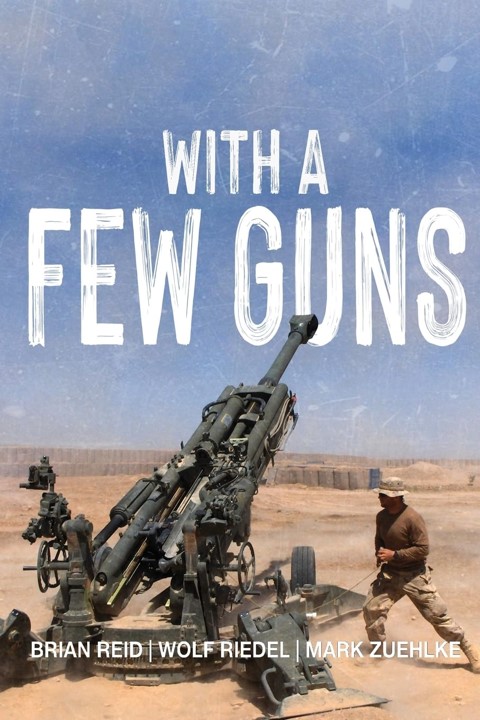Short Bursts:
Book Review - With A Few Guns: The Royal Regiment of Canadian Artillery in Afghanistan Volume I - 2002-2006
Reviewed by Major Nicholas Kaempffer, CD

Colonel (retd.) Riedel, Wolf, OMM, CD, KC
Lieutenant-Colonel (retd.) Reid, Brian, CD
and Zuehlke, Mark
Toronto, Double Dagger Books, 2023
553 pp.
ISBN: 978-1-99044-86-3 (paperback)
978-1-990644-87-0 (ebook)
Since its inception in 1855, The Royal Regiment of Canadian Artillery has been involved in every single Canadian military campaign. However, until now, the story of Gunners within Canada’s longest war remained untold. Within their seminal work With A Few Guns – Volume I – 2002-2006, covering the years from 2002 to 2006, authors Wolf Riedel, Brian Reid, and Mark Zuehlke provide a soldier’s perspective on the experiences of Gunners deployed to Afghanistan. With interviews and accounts from many soldiers that make up the current Regiment, With A Few Guns tells a human story. It charts the evolution of the systems, tactics, and techniques that make up the current state of the primary reserve and regular force artillery.
Starting with combat operations in Kandahar under Operation (Op) APOLLO, the book initially takes readers through the Gunners’ experience in engaging Taliban and al-Qaeda forces in challenging mountainous conditions, including the now-infamous mountain known as “The Whale” (Tergul Ghar). For the first time since the Korean War, Gunners from 1st Regiment, Royal Canadian Horse Artillery fired high-explosive rounds in anger and justified the importance of on-time, on-target firepower in support of manoeuvre elements, around the clock. Following mission termination, the Gunners transitioned to Kabul for Op ATHENA, where the regiment deployed LG1 105mm howitzers and established an Airspace Coordination Centre. Additionally, they fielded novel systems such as the Norwegian ARTHUR radar and French Sperwer Uncrewed Aerial Vehicle.
One could argue that the deployment of Gunners to Kandahar may have saved The Regiment from dissolution. Before engaging in this large-scale combat operations, some questioned the value of artillery, especially following the “peace dividend” that followed the collapse of the Soviet Union. While Canadian Gunners achieved many successes, the effects of years of budget cuts became immediately apparent. As the book notes, underfunding and unrealistic conceptual ideas about fighting a “three block war” came at the cost of blood and treasure.
Referring to a crisis experienced by Canadian Gunners during the Great War, ammunition levels were critically low, as consumption rates during operations such as those leading up to Op MEDUSA greatly strained the logistical chain. Committed operators faced challenges such as ARTHUR radiating hours and SPERWER aircraft losses, highlighting the significant impact of financial and logistic limitations on their operations. The sorry state of Canada’s gun fleet was partially addressed by the fortuitous acquisition of the M777 155mm lightweight towed howitzer, which was purchased before Task Force 1-06 returned to Kandahar. The ensuing chapters provide a harrowing narrative, detailing high-intensity combat against a determined and resolute enemy leading to many Canadians being killed and wounded in action. Throughout, the Guns consistently demonstrated their value time and time again.
By the end of the book, three conclusions were drawn. First, the women and men of The Royal Regiment of Canadian Artillery played a crucial role in Canada’s battlefield successes in the Global War on Terror. They fought against all odds and challenging conditions with a plucky “make do” attitude, especially when it came to the integration of new systems and tactics. Second, some of these successes came at a high cost in terms of personnel and capabilities. Reflecting on the present-day context, it must be noted that Canada does not possess any self-propelled artillery, has divested its only ground-based air defence capability, and fields a great deal of outdated and worn-out equipment. The primary reserve units—which contributed 25 to 30 percent of skilled Gunners to deployments in Afghanistan—have a limited number of serviceable howitzers available for training. As the war in Ukraine demonstrates, the demands of high-intensity conflict against a peer or near-peer adversary require an agile and modern military. The current structure and equipment of The Regiment are arguably based upon the experiences of Afghanistan and do not adequately reflect the requirements demanded by the current security environment within the Euro-Atlantic area.
Lastly, Reid, Riedel and Zuehlke have written a superb, highly accessible history that is a must-read for both soldiers and citizens. The book is meticulously researched as evident in the extensive pages of endnotes and references. The human aspect of combat is a consistent thread throughout the narrative. Leaders at all levels can glean valuable insights from With A Few Guns (Volume 1– 2002-2006) and are likely to conclude with a sentiment of gratitude, acknowledging the significance of the artillery: “The Guns, Thank God, The Guns!”
For the production of Volume II—which will continue the narrative from where Volume I concludes, i.e. until the end of the mission in 2014—Mark Zuehlke will assume the primary role as the lead author, succeeding Colonel (retired) Wolf Riedel. It is crucial to acknowledge the efforts of Lieutenant-Colonel (retired) Brian Reid, who unfortunately passed away before the publication. He played a pioneering role in documenting this significant part of Canada’s military history. Ubique!
ABOUT THE AUTHOR
Major Nicholas Kaempffer, CD, is an artillery officer currently posted to Supreme Headquarters Allied Powers Europe in Mons, Belgium, where he is employed as a Targeting and Joint Fires Staff Officer. He previously commanded the Headquarters Battery at The Royal Regiment of Canadian Artillery School. A graduate of Queen’s University, Major Kaempffer holds a Bachelor of Arts Degree (Honours) in Geography (with distinction). He is a three-time winner of The Royal Regiment of Canadian Artillery’s annual Geoffrey Brooks Memorial Essay competition, and all three submissions were re-published in the Canadian Military Journal. He is a veteran of Canada’s War in Afghanistan.
This article first appeared online in the Short Bursts section of the Canadian Army Journal (October, 2024).